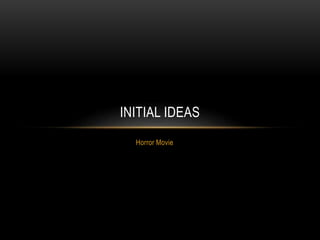
Horror Film Conventions & Techniques
- 2. CONVENTIONS & THEMES • The common conventions of horror films include jump scares, darkness, mystery, suspense, eeriness, unknown, creepy music, jump cuts, loud noises, weapons, blood and death • The common themes of horror films include good vs evil, depression, religion, childhood issues, revenge, supernatural, beyond death, science gone bad, nightmares, zombie apocalypse, lust, madness, insanity, suicide and envy.
- 3. REPRESENTATION (CHARACTERS) • The main protagonist, often the victim or hero of the movie • The villain, often a monster, mutated freak, alien or serial killer. They tend to have a trademark characteristic as to how they kill, e.g. weapons, and who they kill. • The stupid/immortal teenagers that always gets killed • Creepy children, police officers (either good or bad), ghosts, zombies, demons, stalker, werewolf, cheerleader, weirdo, psychopaths.
- 4. FILM LANGUAGE – JUMP CUTS • Horror films use lots of jump cuts in order to create scares for the audience. For example, ‘The Conjuring 2’ utilized jump cuts and a mirror. The protagonist was looking in a mirror, the camera panned to the left so the mirror was out of sight and the audience could see behind the protagonist. The camera then panned back to the mirror where there was a nun stood behind them in the reflection. The camera then panned back to the left where we and the protagonist saw no one behind them. The camera then panned to the right and then the nun is stood in between the protagonist and the mirror, and then screams loudly, frightening the audience. The use of quick jump cuts builds suspense and tension for the audience before scaring them.
- 5. FILM LANGUAGE – JUMP SCARES • A jump scare is a key part to every horror movie. They are what the audience want to see when they go to see a horror film as the jump scares in a horror film is what puts the audience on the edge of their seats and keeps them anxious. A good horror film will have multiple jump scares, and will use them unexpectedly to surprise the audience. A good jump scare will build tension, making it seem obvious for the audience that a jump scare is soon approaching. However, it will then come earlier than expecting or they wont put one in at all, lets the tension drop and then use a jump scare. This is key for good horror films as the audience doesn’t know what is going to happen and will be scared when it does.
- 6. STRUCTURE • Horror films usually follow similar plot lines and conventions. They all have similar protagonists that will face an issue they have to overcome to either save someone or be with the person they love. However this barrier grows and grows as a problem, making it harder for the protagonist to overcome. • Horror movies usually have similar protagonists, and similar reasons to be scared. For example, many horror films feature ghosts or spirits that haunt a house. The house is usually home to a young girl who is either possessed or scared and needs protecting. These are common conventions used in many horror films and because they work, they are repeated and copied for many other horror movies and so the structure continues.
- 7. AUDIENCE • The vast majority of horror films are 18’s with a few being 15’s. This is because they contain blood and gore, and are not really suitable for younger audiences. This reduces the potential target audience for the film, but does increase their capabilities as a production company to make a scary film for those that do meet the age restrictions. This means that the production company can make a good film and so can build up a good brand image. The audience will want a very scary film, and so a low age rating would not be sufficient to allow the production company to make a scary film. Horror films are most watched by males between 25-40. They all want to be scared and tested to see how tough they can be in front of others.